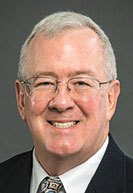Subscriber Benefit
As a subscriber you can listen to articles at work, in the car, or while you work out. Subscribe Now
Employers are doing a lot less hiring than they were a year ago—a sign that the job market in Indianapolis, and nationwide, has cooled considerably.
In December, for instance, employers in the nine-county Indianapolis area posted openings for a total of 52,535 jobs—a 47% drop from the 99,289 job openings posted in December 2022. Similar year-over-year declines also happened in September, October and November.
Indy Chamber provided IBJ with the proprietary data from labor-market analytics firm Lightcast.
“We were really busy last year with recruiting from January to probably June, maybe July, and then I would say things started to slow down,” said Peggy Hogan, vice president of client services at Carmel-based Purple Ink HR Consulting. Purple Ink offers a variety of human resources services, including helping clients recruit employees.
“I just think people have really paused, and they’re really taking their time,” Hogan said.

But the steep dropoff isn’t a sign of a distressed job market, according to Ball State University economist Michael Hicks. Rather, he said, it’s a return to more normal conditions following the demand for employees that peaked in mid-2022 due to pandemic-related economic conditions.
According to the Lightcast data, Indianapolis-area job postings remained above 100,000 for a 20-month period from April 2021 to November 2022, reaching a peak of 115,650 in May 2022.
That period, Hicks said, represented a “really crazy high, more job openings than in any time that we have data for.” (Data on job openings began to be collected on a regular basis in the early 2000s, he said.)
In comparison, during the pre-pandemic year of 2019, monthly job postings ranged from a low of 78,114 in January to a high of 92,577 in March.
Hicks pointed out that the drop in job postings hasn’t been accompanied by an increase in unemployment. Indiana’s unemployment rate in November was 3.7%, up only slightly from October’s 3.6%.
Economists generally consider an unemployment rate lower than 5% to represent full employment.
In comparison, during the early days of the pandemic, Indiana’s unemployment rate spiked to 16.9% in April 2020.
The combination of a slowed job market and sustained low unemployment, Hicks said, indicates that the Federal Reserve has succeeded in its strategy of raising interest rates enough to tame inflation without tipping the economy into recession.
“They’re very strong indicators of a soft landing,” Hicks said.
Ordinarily, he said, a slowing economy is marked by heavier layoffs than we’ve seen recently. Things are different now, he said, because the labor market had previously been so tight that many employers were operating with unfilled positions. Once the economy started to cool, those companies didn’t necessarily cut back on staffing—they just slowed down their hiring.
One way the slowdown has manifested itself, Hogan said, is that employers are being more selective about the people they do hire. “There’s just a lot more care about who they get in now. Companies are saying, ‘I don’t want to rush this. I want to make sure it’s the right person.’”
Hogan said the employers that are hiring now are mostly filling vacancies created by a previous employee’s departure. They’re less likely to be adding jobs.

Hope Williams, director of talent at Indianapolis-based venture studio High Alpha, said the hiring slump started earlier for many of High Alpha’s portfolio companies.
Companies had lots of job openings in 2020 to 2022, Williams said, but 2023 was “very different.”
High Alpha launches and invests in business-to-business software companies, and the software industry has been affected by the larger tech industry downturn that began in mid-2022.
Williams said High Alpha’s portfolio companies are being more “conscious” in their hiring now, taking the time to determine what skills they most need applicants to have. Previously, companies couldn’t be so choosy.
“Back in 2020, 2022, it was really difficult to find talent for these positions,” she said. “And now, with every opportunity, there’s a lot of people available or interested in these opportunities.”
One result of this, Williams said, is that it’s been easier for High Alpha’s portfolio companies to find good employees. Several large tech companies had significant layoffs last year, she said, and some of those laid-off employees might be open to working at a small High Alpha startup.
“It’s been a really great time to hire some exceptional talent,” Williams said.
Not every employer is seeing a hiring slowdown.
Indianapolis-based CertaSite, which offers fire and life safety products and services such as fire alarms, emergency lighting and first-aid kits, is in full hiring mode—mostly because the company itself is growing rapidly.
Founded in 2018, CertaSite has acquired more than 20 companies and has about 450 employees in several Midwestern states, including 50 at the company’s Indianapolis headquarters. Five full-time recruiters are currently working to fill 83 positions throughout the company.

“It’s the largest our recruiting team has ever been,” said Kara Ferguson, CertaSite’s human resources director.
Most of CertaSite’s workforce, Ferguson said, consists of technicians who are required to have specific training, licenses and certifications. The competition for such employees is fierce, she said, and CertaSite has raised its pay twice in the past year to lure candidates from competing firms.
Entry-level pay for apprentices with no experience begins at $20 per hour. The most seasoned employees earn above $36 per hour, Ferguson said.
Even at these pay rates, she said, “it is still very, very difficult to get candidates to pick up the phone.”
The job market has eased somewhat, though, even at CertaSite.
In 2020 and 2021, Ferguson said, about half of new hires ghosted the company before their first day of work. That is, the candidates passed their required drug screenings, background checks and other screening requirements, and they even scheduled a first day of work. Then they didn’t show up and never called to say why.
Now, Ferguson said, only about two in 10 new hires pulls a disappearing act.
Looking ahead, Ball State’s Hicks predicted that the decline in job postings has stabilized, or close to it, especially since the Federal Reserve has signaled that it intends to pause its series of interest-rate hikes. “I think [the declines] are probably close to leveling out.”
Hicks said the pandemic-induced disruptions—the jobs fluctuations, mass layoffs in early 2020, billions in federal stimulus money to keep the economy afloat, inflation, interest rate increases to combat that inflation, big changes in consumer spending, remote-work patterns and supply chain disruptions—are still affecting the economy.
And it will be a long time yet before those impacts play themselves out fully, Hicks said. “All the rest of our professional lives will be affected by the pandemic.”•
Please enable JavaScript to view this content.
